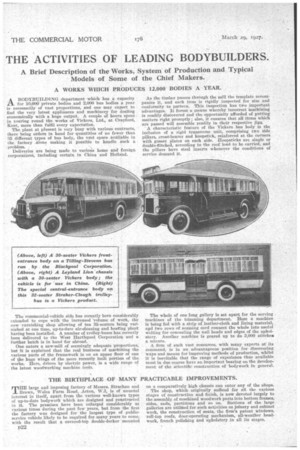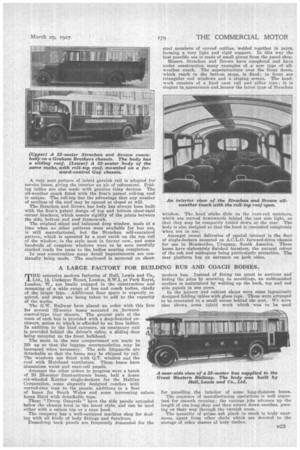THE BIRTHPLACE OF MANY PRACTICABLE IMPROVEMENTS.
Page 92

Page 93

If you've noticed an error in this article please click here to report it so we can fix it.
MITE large and imposing factory of Messrs. Strachan and J. Brown, Wales Farm Road, Acton, W.3, is of unusual interest in itself, apart from the various well-known types of up-to-date bodywork which are designed and constructed in it. The premises have been enlarged considerably at various times during the past few years, but from the first the factory was designed for the largest type of publicservice vehicle likely to be required for.many years to come, with the result that a covered-top double-decker mounted
on a comparatively high chassis can enter any of the shops.
The shop, which originally sufficed for all the various stages of eonstrnction and finish, is now devoted largely to the assembly of machined woodwork parts into bottom frames, sides, ends, partitions and so on. Sections of the large galleries are utilited for such activities as joinery arid cabinet work, the construction of seats, the firm's patent windows, roll-top roofs, door-operating mechanism, all-weather headwork, french polishing and upholstery in all its stages. A very neat pattern of inlaid garnish rail is adopted for service buses, giving the interior an air of refinement. P.olding tables are also made with genuine inlay devices. The all-weather coach fitted with the firm's patent roll-top roof is unique. The roll-top has the advantage that any number of sections of the roof may be opened or closed at will.
The Strachan and Brown bus body has always been built with the firm's patent design of tap and bottom sheet-steel corner brackets, which ensure rigidity of the joints between the side, bottom and roof framework.
The original silent and balanced drop window, made at a time when no other patterns were available for bus use, is still manufactured, but the Strachan self-contained pattern, which is operated by a neat catch on the top rail of the window, is the style most in favour now, and some hundreds of complete windows were to be seen carefully stacked ready for issue to the bodies nearing completion.
In seat construction many detail improvements are continually being made. The seatboard is mounted on sheet
steel members of curved outline, welded together in pairs, forming a very light and rigid support. In this way the best possible use is made of small pieces from the panel shop. Messrs. Strachan and Brown have completed and have under construction many examples of a new type of allweather coach. The superstructure over the front doors, which reach to the bottom steps, is fixed ; in front are triangular end windows and a sloping screen. The headwork consists of a fixed cant rail and pillar tops ; it is elegant in appearance and.housos the latest type of Strachan
window. The hood sticks slide on the cant-rail members, which are curved downwards behind the last side light, so that they may be compactly folded down at the rear. The body is also designed so that the hood is concealed completely when not in use.
Amongst recent deliveries of special interest is the fleet of single-deckers mounted on A.C.L.O. forward-drive chassis for use in Montevideo, Uruguay, South America. These buses have elaborately finished interiors, the natural colour of the ash and mahogany being particularly attractive. The rear platform has an entrance on both sides.












































































































































































